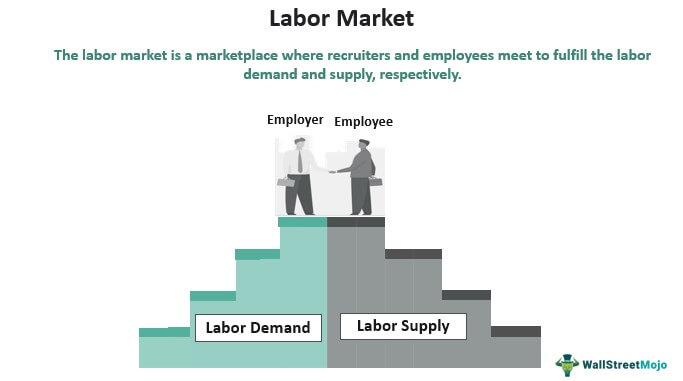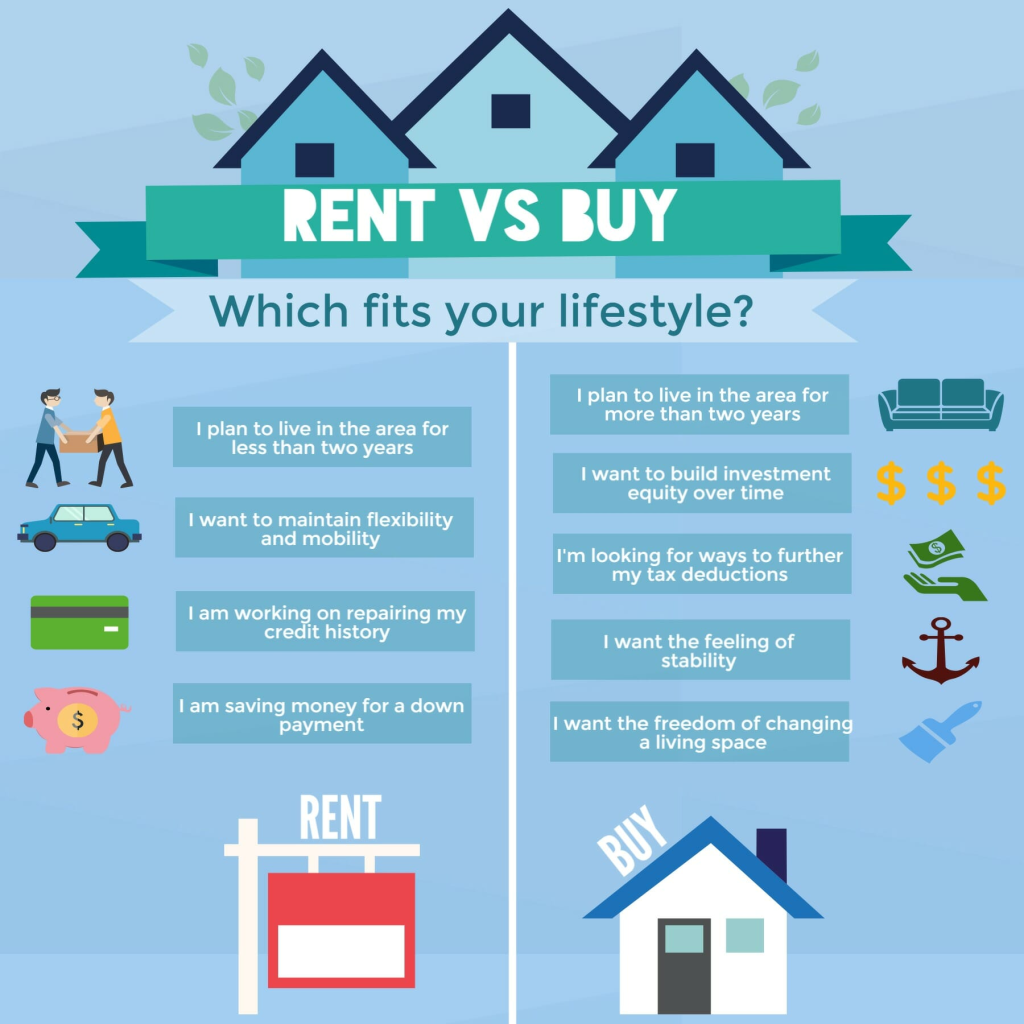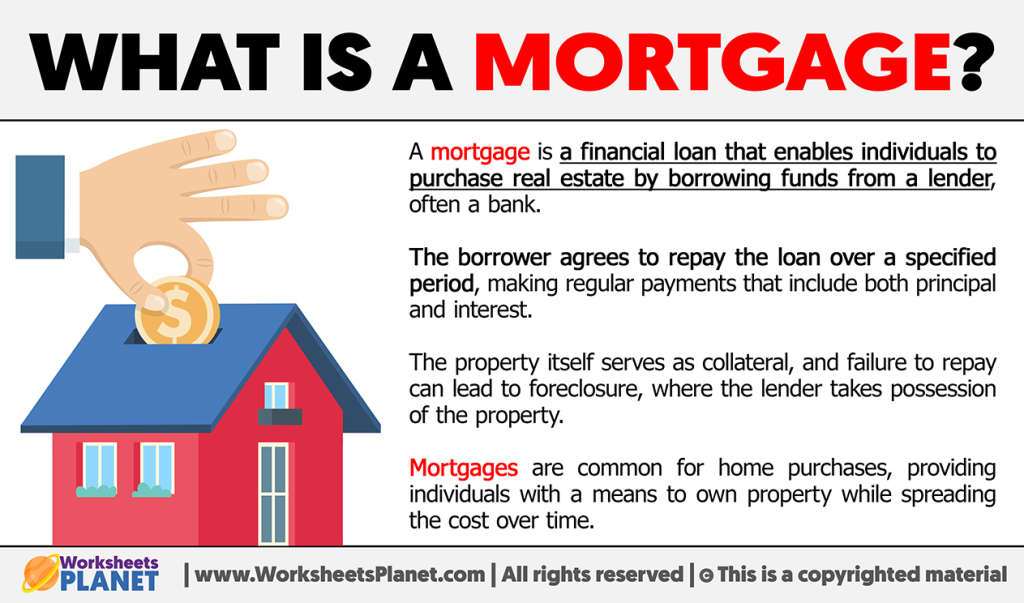Capítulo 14: Bienes raíces y propiedad de vivienda
Objetivos de aprendizaje de la lección:
Lorem ipsum dolor sit amet, consectetur adipiscing elit. Ut elit tellus, luctus nec ullamcorper mattis, pulvinar dapibus leo.
Real estate and homeownership involve understanding contracts, the impact of economic conditions on housing decisions, and the financial implications of renting versus buying. Here’s an exploration of these aspects to guide individuals through the complexities of real estate decisions.
Cifra: A Guide to the Homebuying Process
Descripción:
This infographic provides a step-by-step visual guide to the homebuying process, outlining the journey from the initial thought of buying to finally receiving the keys. It breaks down the complex process into manageable stages, such as financial preparation, house hunting, and the final closing. The purpose is to demystify the experience for potential homebuyers so they know what to expect.
Conclusiones clave:
- The homebuying process starts long before you look at houses; the first step is financial preparation, which includes getting pre-approved for a mortgage to set your budget.
- A crucial phase after finding a home and having an offer accepted is the due diligence period, which involves a home inspection to assess the property’s condition.
- The process involves several key professionals, including a real estate agent, a loan officer, and an inspector, who guide you through the various stages.
- The final step is the closing, where all legal documents are signed, funds are transferred, and ownership of the property officially passes to you.
Application of Information:
- This guide acts as a valuable checklist for prospective homebuyers, helping you understand each step and stay organized throughout the purchasing journey.
- By knowing what’s coming next, you can proactively prepare your finances and documents, leading to a smoother and less stressful transaction.
- This knowledge empowers you to make more confident and informed financial decisions at every stage, from choosing the right loan to negotiating the final sale price.
14.1 Understanding Contracts
Key Terms and Conditions:
- Contracts, whether digital or paper, contain critical terms such as duration, termination clauses, payment terms, and dispute resolution methods. Understanding these terms is essential to protect your rights and responsibilities.
Contracts, whether for real estate transactions or web application agreements, include several key terms that dictate the obligations and rights of all parties involved. Here’s a breakdown:
1. Duration
Definition: Specifies how long the contract remains valid. It includes the start and end dates, and may outline renewal conditions (automatic or optional).
Ejemplo:
A cell phone contract might state: “This agreement begins on January 1, 2025, and remains in effect until December 31, 2026. The contract will automatically renew for another 12 months unless canceled in writing 30 days prior to the expiration date.”
2. Termination
Definition: Outlines how and when either party may end the agreement before the official end date, including any penalties or notice requirements.
Ejemplo:
In a rental lease agreement: “The tenant may terminate the lease with 60 days’ written notice and payment of a $500 early termination fee. The landlord may terminate for non-payment of rent or lease violations with 30 days’ notice.”
3. Payment Terms
Definition: Describes the amounts owed, when payments are due, acceptable payment methods, and consequences for late or missed payments.
Ejemplo:
A freelance graphic designer contract might read: “The client agrees to pay $2,000 in two installments: 50% upfront, and 50% upon project completion. Late payments incur a 5% penalty after 10 business days.”
4. Dispute Resolution
Definition: Identifies the process to follow if disagreements arise, such as mediation, arbitration, or litigation, and the location where disputes will be settled.
Ejemplo:
A software subscription agreement may state: “Any disputes arising from this agreement will be resolved through binding arbitration in the state of California. The parties waive their right to a jury trial.”
5. Privacy and Sharing of Personal Information
Definition: Explains how your personal data is collected, used, stored, and whether it’s shared with third parties. Must comply with data protection laws like GDPR (EU) or CCPA (California).
Ejemplo:
A budgeting app’s privacy policy might say: “We collect your name, email address, and banking data to provide our services. We do not sell your information to third parties. You can request data deletion under the CCPA.”
⚠️ Tip: Always read these clauses before agreeing, especially in digital contracts like signing up for apps or services. Your data may be shared with partners for marketing or analytics purposes.
6. Privacy Policies and Data Sharing Terms
Definition: These terms clarify how a company collects, stores, uses, and potentially shares personal information. They often reference compliance with regulations like the General Data Protection Regulation (GDPR) in Europe or the California Consumer Privacy Act (CCPA) in the U.S.
Ejemplo:
When signing up for a social media app, you might see:
“By using our services, you agree to our privacy policy. We collect data such as your location, browsing history, and contacts. This data may be shared with advertisers to personalize your experience. You may opt out of data sharing in your settings, and request deletion of your data at any time.”
Real-Life Scenario: Before downloading a popular budgeting app, Jamie thoroughly reads the terms and conditions, focusing on the privacy policy to ensure personal financial data remains secure.
14.2 Economic and Labor Market Conditions
Impact on Housing Decisions:
- Economic downturns and shifts in the labor market can significantly affect income stability, influencing whether individuals choose to rent or buy. Job security becomes a crucial consideration.
- Technological advancements can both create new career opportunities and render certain jobs obsolete, affecting long-term housing decisions.
- Economic downturns disproportionately affect individuals based on their education, experience, employment type, ethnicity, and gender.
- Those with less education and experience, temporary or gig workers, and certain ethnic groups may face higher unemployment rates.
- Economic resilience often correlates with higher education levels, specialized skill sets, and industries less sensitive to economic cycles.
Real-Life Scenario: After a major tech company announces layoffs, Alex decides to continue renting despite having saved enough for a down payment, prioritizing financial flexibility over homeownership amid uncertain job prospects.
Cifra: Understanding the Labor Market
Descripción:
This image provides a clear and simple definition of the labor market, the system where employment and wages are determined. It visually represents the two core components: the supply of labor, which comes from individuals seeking work, and the demand for labor, which comes from businesses looking to hire. The graphic explains that the interaction between these two forces sets the price of labor, which is the wage level.
Conclusiones clave:
- El labor market is the broad term for the interaction between workers (supply) and employers (demand).
- El “price” of labor is the wage, which tends to increase when demand for workers is high and the supply of qualified workers is low.
- Key metrics used to analyze the health of the labor market include the unemployment rate y el labor force participation rate.
- A “tight” labor market, where there are more job openings than available workers, generally gives more bargaining power to employees.
Application of Information:
- The health of the labor market is a critical indicator of the overall health of the economy, making it essential information for investors and policymakers.
- As an individual, understanding labor market trends can help you make informed career choices by identifying industries and skills that are in high demand.
- For investors, positive labor market news, such as strong job growth, often signals a growing economy, which can be beneficial for corporate profits and the stock market.
14.3 Renting vs. Buying
Financial and Personal Considerations:
- Young adults may prefer renting for the flexibility it offers, avoiding the long-term financial commitment and maintenance responsibilities of homeownership.
- Comparing the costs and benefits of renting versus buying involves analyzing monthly payments, potential home appreciation, and personal lifestyle preferences.
The decision to rent or buy is influenced by financial status, lifestyle preferences, and long-term plans. Here’s how they compare:
- Short-term Costs and Benefits of Renting:
- Lower upfront costs (security deposit vs. down payment).
- Flexibility to move.
- No maintenance costs.
- Long-term Costs and Benefits of Buying:
- Potential for property value appreciation.
- Builds equity over time.
- Possible tax deductions on mortgage interest
Real-Life Scenario: Sara compares renting and buying in her city. She calculates that while her monthly mortgage payments might be higher than rent, the potential for home equity growth makes buying a financially sound long-term decision.
In some cases, individuals may encounter rent-to-own agreements, especially for homes or furniture. While renting-to-own offers flexibility and the chance to eventually own the property or item, it often results in paying significantly more over time compared to buying outright.
Buying a home directly builds equity and may lead to long-term financial stability, while renting (or rent-to-own) provides short-term flexibility but little or no ownership benefits until all payments are made.
Key Rental Contract Terminology
1. Lease Term: Duration of the rental agreement
- Definición: Specifies the length of time the tenant agrees to rent the property.
- Ejemplo:
A lease agreement states: “This lease shall begin on August 1, 2025, and end on July 31, 2026.”
This indicates a 12-month lease term during which both the landlord and tenant are bound by the lease conditions.
2. Security Deposit: Funds held by the landlord as insurance against damage or unpaid rent
- Definición: A refundable amount paid upfront to cover potential property damage or lease violations.
- Ejemplo:
Upon signing a lease, John pays $1,200 as a security deposit in addition to his first month’s rent. When he moves out, the landlord inspects the apartment. Because John left a hole in the wall and didn’t clean the carpets, the landlord keeps $300 to cover the repairs and refunds the remaining $900.
3. Grace Period: Time allowed after the due date for rent payments without penalty
- Definición: A short period during which late payments are accepted without a fee.
- Ejemplo:
A lease states: “Rent is due on the 1st of each month. A 5-day grace period is provided before late fees are applied.”
If Maria pays her rent on the 4th, she avoids a penalty; if she pays on the 6th, she owes a $50 late fee.
4. Eviction: Legal process by which a tenant is removed for violating lease terms
- Definición: The formal removal of a tenant from the rental property due to non-payment or other breaches.
- Ejemplo:
After failing to pay rent for two months and ignoring multiple notices, David receives an official eviction notice from the landlord. The court sets a hearing, and eventually David is legally required to vacate the property within 10 days.
Cifra: Renting vs. Buying a Home: A Comparison
Descripción:
This image provides a side-by-side comparison of the pros and cons of renting versus buying a home. It breaks down the key differences between the two choices, focusing on factors like cost, responsibility, and financial benefits. The goal is to provide a balanced overview to help individuals make an informed decision that suits their lifestyle and financial situation.
Conclusiones clave:
- The main advantage of renting is flexibility, as it’s easier to move, and you are not responsible for maintenance costs or property taxes.
- The primary benefit of buying a home is building equity, which is a form of forced savings that helps you grow your net worth over time.
- Homeownership comes with significant additional costs beyond the mortgage payment, including repairs, insurance, and property taxes.
- The “rent vs. buy” decision is not purely financial; it is also a major lifestyle choice that depends on your long-term goals, career stability, and personal preferences.
Application of Information:
- This framework provides a clear checklist of factors to consider when you are making the major financial decision of whether to rent or buy.
- It encourages you to analyze your complete financial picture, including your savings for a down payment and your ability to cover unexpected maintenance costs.
- By weighing these pros and cons against your personal goals and financial stability, you can make a choice that best supports your long-term financial well-being.
14.4 Mortgage Basics
Secured Loans and Mortgages:
- Mortgages are secured loans, with the purchased home serving as collateral. Failure to make payments can lead to foreclosure, unlike unsecured debts like credit card loans.
- Understanding mortgage terms, such as fixed-rate versus adjustable-rate mortgages (ARMs), is critical. Fixed-rate mortgages offer predictable payments, while ARMs may offer lower initial rates but pose the risk of future payment increases.
- The property being purchased typically serves as collateral for a mortgage loan. This means if the borrower fails to make payments, the lender has the right to take possession of the property to recover the loan amount.
Real-Life Scenario: Considering a stable job and a preference for predictable payments, Chris opts for a 30-year fixed-rate mortgage over an ARM when purchasing a first home, valuing long-term financial stability.
Cifra: What is a Mortgage?
Descripción:
This image provides a simple, educational overview of what a mortgage is, explaining it as a loan used to purchase a home. It likely illustrates the core relationship where a lender provides a large sum of money to a borrower, who then repays it in installments over many years. The goal is to define this fundamental financial concept in an easy-to-understand visual format.
Conclusiones clave:
- A mortgage is a specific type of long-term loan from a bank or financial institution that helps you buy a house.
- The property you buy with the loan serves as collateral, meaning the lender can take possession of the home if you fail to make your payments.
- Mortgages are typically repaid through regular monthly payments over a long period, commonly 15 to 30 years.
- Each monthly payment consists of two main parts: the principal (the original loan amount) and the interest (the cost of borrowing the money).
Application of Information:
- Understanding the concept of a mortgage is the foundational first step for anyone aspiring to achieve homeownership.
- This knowledge is critical for assessing your financial readiness to buy a home and for comparing different loan options from various lenders.
- Grasping the long-term commitment of a mortgage helps you make a responsible and well-informed financial decision when purchasing what is likely your largest asset.
Key Mortgage Qualification Factors
When applying for a mortgage, two important financial ratios lenders consider are:
- Debt-to-Income (DTI) Ratio:
Measures how much of your monthly income goes toward debt payments.
Ejemplo: If your total debt payments are $1,800 and your monthly income is $5,000, your DTI = 36%.
Lenders typically prefer a DTI below 36%.
- Loan-to-Value (LTV) Ratio:
Compare the size of your mortgage to the home’s value.
Ejemplo: If you buy a $250,000 home with a $50,000 down payment, your loan is $200,000. Your LTV = 80%.
A lower LTV reduces lender risk and can help you avoid private mortgage insurance (PMI).
Understanding these ratios can improve your chances of qualifying for better mortgage terms.
14.5 Comparing Mortgage Payments
Loan Term | Amount Borrowed | Interest Rate | Monthly Payment |
30 Years | $250,000 | 4.0% | $1,193.54 |
15 Years | $250,000 | 3.5% | $1,787.21 |
30 Years | $350,000 | 4.5% | $1,773.40 |
15 Years | $350,000 | 4.0% | $2,584.17 |
Calculations are illustrative and based on fixed interest rates. Actual payments can vary based on specific loan conditions and fluctuating interest rates.
These examples help demonstrate how differences in loan terms, amounts, and interest rates can significantly impact monthly mortgage payments. Longer repayment periods typically result in lower monthly payments but higher total interest paid over the life of the loan.
14.6 Homeownership Costs
Owning a home comes with ongoing costs that you should consider when budgeting for homeownership. These costs include:
- Property Taxes: Property taxes are levied by local governments based on the assessed value of your property. Tax rates vary depending on your location and can change over time. Property taxes are typically paid annually or semi-annually and are often included in your monthly mortgage payment.
- Homeowner’s Insurance: Homeowner’s insurance protects you from financial losses due to damage to your property or personal liability. The cost of homeowner’s insurance depends on factors such as your home’s value, location, and coverage limits. Shop around and compare quotes from multiple insurance providers to find the best policy for your needs. Homeowners’ insurance typically covers damages to the home from events like fire, storms, theft, and certain natural disasters. It also includes liability coverage if someone is injured on the property.
- Renters’ insurance, on the other hand, covers personal belongings inside a rented property, such as clothing, electronics, and furniture, but not the building structure itself.
Both types of insurance are important for protecting against unexpected losses.
- Mantenimiento y Reparaciones: As a homeowner, you’re responsible for maintaining your property and addressing any necessary repairs. Regular maintenance tasks, such as lawn care, gutter cleaning, and HVAC servicing, can add up over time. Additionally, unexpected repairs, such as roof replacement or plumbing issues, can be costly. It’s essential to budget for these ongoing expenses and set aside an emergency fund to cover unexpected costs.
Understanding the various aspects of real estate and homeownership can help you make informed decisions and navigate the complex world of buying, financing, and maintaining a home. The Simple Financial Community is here to support you on your financial journey, offering resources and guidance to help you make the best choices for your homeownership goals.
14.7 Tenant and Landlord Rights and Responsibilities
Rental lease agreements outline important rights and obligations:
- Tenants have the right to a safe, habitable living environment and are responsible for timely rent payments and maintaining the property.
- Landlords have the right to collect rent and expect property upkeep, but must handle repairs and maintenance promptly.
Understanding these terms protects both parties and helps prevent legal disputes.
Conclusión
Navigating real estate and homeownership requires careful consideration of contracts, economic conditions, and personal circumstances. Whether choosing to rent or buy, understanding mortgage options, and comparing investment benchmarks, informed decisions can lead to greater satisfaction and financial well-being in the realm of real estate.
Información clave de la lección:
Lorem ipsum dolor sit amet, consectetur adipiscing elit. Ut elit tellus, luctus nec ullamcorper mattis, pulvinar dapibus leo.





